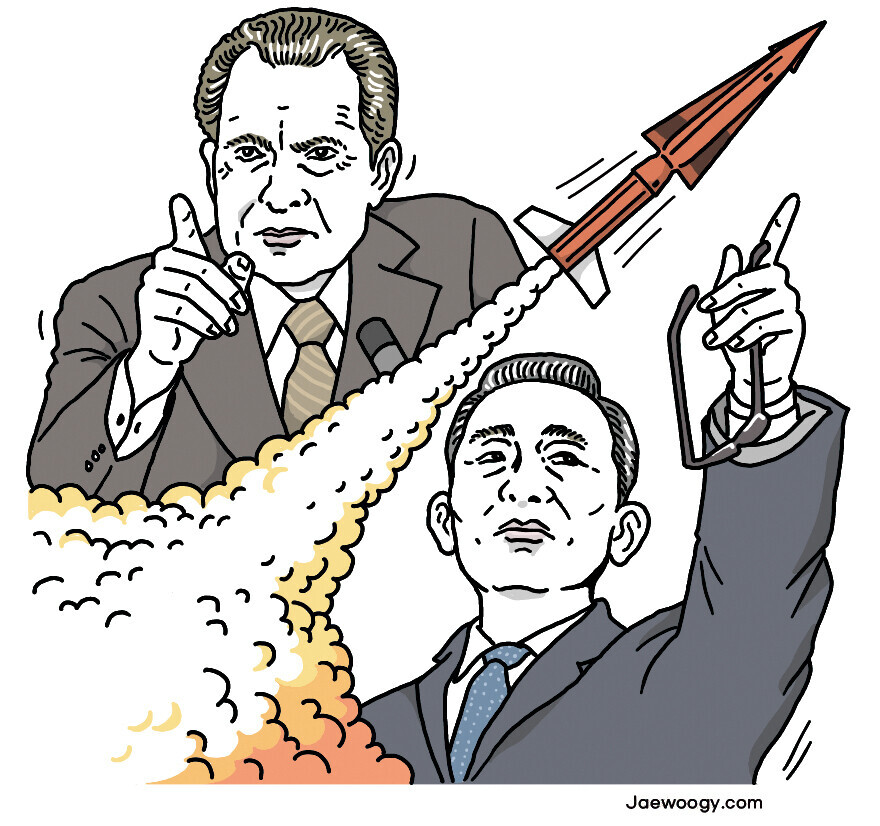hankyoreh
Links to other country sites 다른 나라 사이트 링크
[Column] Nixon Doctrine, Baekgom-1, South Korea-US missile guidelines

In 1969, the US began to withdraw from Vietnam under the Nixon Doctrine, which held that Asian countries should handle their own problems. In 1971, the US also withdrew the 7th Infantry Division from Dongducheon, Gyeonggi Province, despite the protest of South Korea, which had aided the US by deploying 50,000 soldiers to Vietnam.
Then-South Korean President Park Chung-hee, no longer able to trust the US, took measures to set the country’s national defense on an independent basis. He launched a military buildup called the “Yulgok Project” and began secretly developing nuclear weapons and missiles.
For security purposes, these weapon development programs were given misleading names. In 1974, Park approved the missile development program under the name of the “aviation industry plan.”
A guided missile laboratory was labeled the Daejeon Machine Works, while the Agency for Defense Development’s flight-testing site at Anheung — in Taean, South Chungcheong Province — was disguised as the Anheung Weather Bureau.
South Korea’s successful test launch of a missile on Sept. 26, 1978, made it the seventh country in the world to develop missiles. Korea’s first locally developed missile was a surface-to-surface missile modeled on the US’s Nike Hercules.
The missile was nicknamed the “Baekgom,” meaning “white bear.” On a snowy day in the winter, staff working outside at the Anheung flight testing site were said to look like polar bears.
The major powers in the region reacted testily to Baekgom’s launch, regarding the missile as a nuclear weapon delivery system.
The Asahi Shimbun, a Japanese newspaper, concluded that the missile was “probably connected” to nuclear development, while the Soviet Ministry of Defense released a statement warning of South Korea’s “nuclear development.”
The US also questioned Seoul about whether it intended to move from ballistic missiles to nuclear weapons and pressured it to limit the range of its missiles to 180 kilometers, which would be enough to strike Pyongyang from Seoul.
A string of senior Americans — US Forces Korea Commander Gen. John Wickham, the American ambassador to South Korea, and even a special envoy from the US government — visited the Agency for Defense Development to ask South Korea to stop developing missiles.
In July 1979, Wickham sent a letter to South Korean Defense Minister Roh Jae-hyun asking him to stop making missiles. That September, Noh replied that South Korea would ensure that any missiles it developed would remain within a payload of 500 kilograms and a range of 180 kilometers, that being the range the US was willing to tolerate.
That marked the beginning of the missile guidelines that were terminated during the recent summit between South Korean President Moon Jae-in and US President Joe Biden.
The agreement has been called the “South Korea-US missile guidelines,” but a more accurate name is just “missile guidelines.” They weren’t a bilateral agreement, but rather voluntary restrictions on missile development announced and implemented by South Korea.
By Kwon Hyuk-chul, editorial writer
Please direct comments or questions to [english@hani.co.kr]

Editorial・opinion
![[Column] Park Geun-hye déjà vu in Yoon Suk-yeol [Column] Park Geun-hye déjà vu in Yoon Suk-yeol](https://flexible.img.hani.co.kr/flexible/normal/500/300/imgdb/original/2024/0424/651713945113788.jpg) [Column] Park Geun-hye déjà vu in Yoon Suk-yeol
[Column] Park Geun-hye déjà vu in Yoon Suk-yeol![[Editorial] New weight of N. Korea’s nuclear threats makes dialogue all the more urgent [Editorial] New weight of N. Korea’s nuclear threats makes dialogue all the more urgent](https://flexible.img.hani.co.kr/flexible/normal/500/300/imgdb/original/2024/0424/7317139454662664.jpg) [Editorial] New weight of N. Korea’s nuclear threats makes dialogue all the more urgent
[Editorial] New weight of N. Korea’s nuclear threats makes dialogue all the more urgent- [Guest essay] The real reason Korea’s new right wants to dub Rhee a founding father
- [Column] ‘Choson’: Is it time we start referring to N. Korea in its own terms?
- [Editorial] Japan’s rewriting of history with Korea has gone too far
- [Column] The president’s questionable capacity for dialogue
- [Column] Are chaebol firms just pizza pies for families to divvy up as they please?
- [Column] Has Korea, too, crossed the Rubicon on China?
- [Correspondent’s column] In Japan’s alliance with US, echoes of its past alliances with UK
- [Editorial] Does Yoon think the Korean public is wrong?
Most viewed articles
- 1[Column] Park Geun-hye déjà vu in Yoon Suk-yeol
- 2Thursday to mark start of resignations by senior doctors amid standoff with government
- 3Kim Jong-un expressed ‘satisfaction’ with nuclear counterstrike drill directed at South
- 4[Column] ‘Choson’: Is it time we start referring to N. Korea in its own terms?
- 5N. Korean hackers breached 10 defense contractors in South for months, police say
- 6Will NewJeans end up collateral damage in internal feud at K-pop juggernaut Hybe?
- 7Why Korea shouldn’t welcome Japan’s newly beefed up defense cooperation with US
- 8[Editorial] New weight of N. Korea’s nuclear threats makes dialogue all the more urgent
- 9[Guest essay] The real reason Korea’s new right wants to dub Rhee a founding father
- 10[Column] Yoon’s first 100 days should open our eyes to pitfalls of presidential system